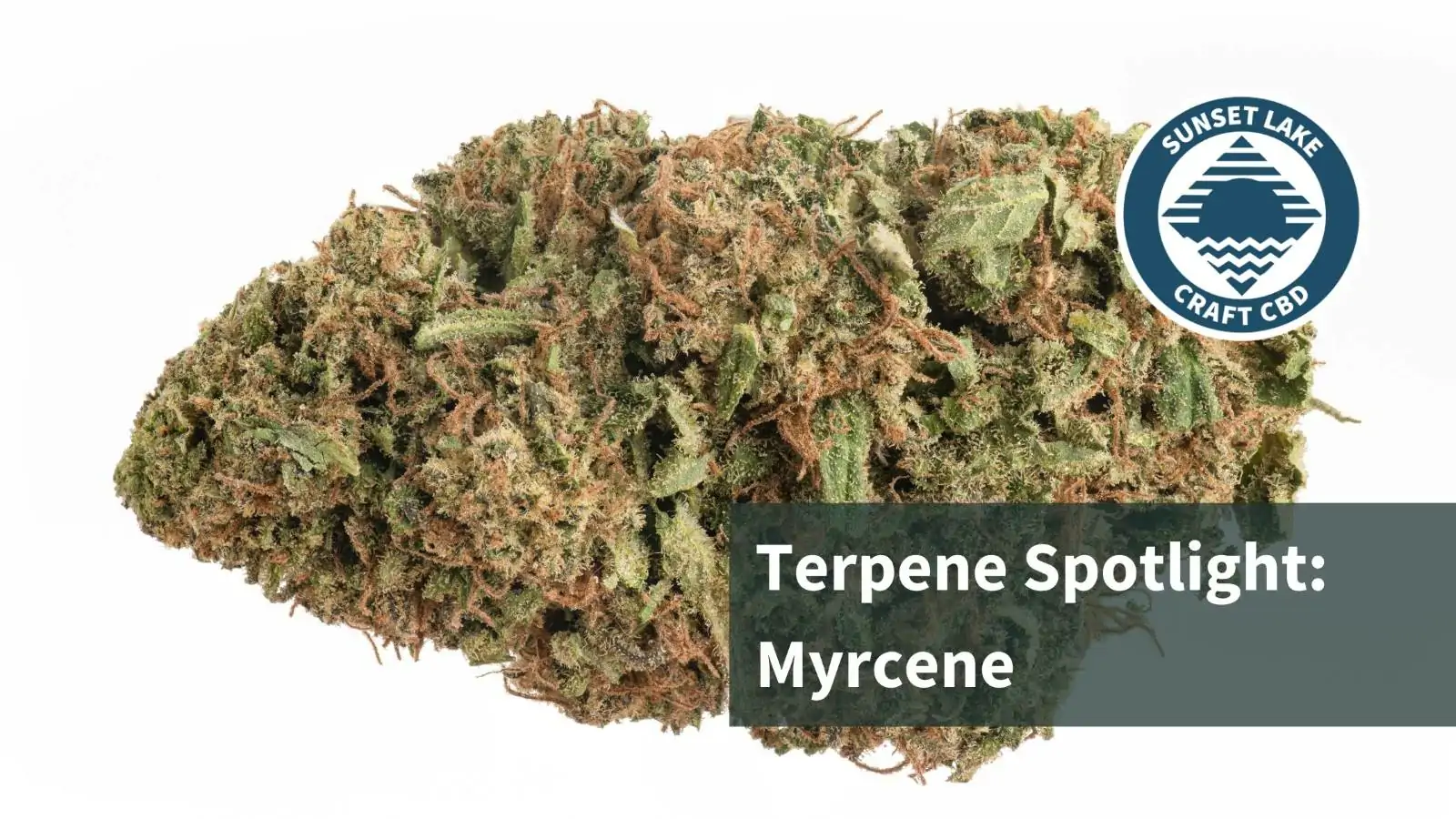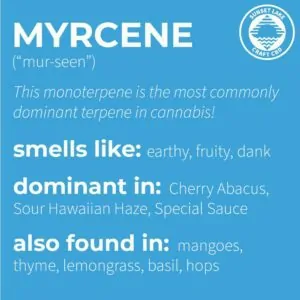No products in the cart.
Terpene Spotlight: Myrcene

As public attention and research continue to explore all the potential benefits of hemp, many consumers are increasingly interested in cannabis’s active components beyond just CBD and THC. Terpenes feature prominently in the discussion about how hemp smells and how it makes you feel. There are dozens of terpenes found in hemp flowers, and the most common terpene in hemp is Myrcene (“mur-seen“).
In this post, we’ll discuss,
- What Myrcene is,
- Where you can find it in nature,
- And what its potential benefits may be
What Are Terpenes?
Before we dive into Myrcene, let’s review what terpenes are. Terpenes are organic molecules responsible for the aroma of fruits, flowers, and some animals. You’ve likely encountered many in your own home without even knowing. For example, do you know that clean, acidic smell you get when you peel an orange or lemon? That’s due to a terpene called limonene, which you can find in all citrus fruits.
Other examples of terpenes include:
- Pinene is responsible for the fresh scent of Pine trees (and Pinesol)
- Linalool is responsible for in lavender flowers calming nature
- Ocimene gives basil its delicious, herb-y aroma.
Technically speaking, terpenes are volatile hydrocarbons, meaning they like to turn into gas and diffuse into the surrounding atmosphere. That’s why it’s easier to associate terpenes with their smell than anything else.
Read more: What Are Terpenes? Terpenes 101
What Is Myrcene?
Myrcene is a monoterpene made up of two isoprene units, which are the basic building blocks of all terpenes. Isoprene units consist of five carbon atoms and eight hydrogen atoms. Alone, they’re a bit boring, but they shine when configured into groups of two, three, four, and so on.
Myrcene, as we mentioned, is made of two isoprene units, so it is relatively basic. But that doesn’t mean that this terpene doesn’t pack a punch. You can find Myrcene in mangoes, thyme, lemongrass, cardamom, hops, and hemp. Its aroma is complex and musky but fruity with notes of hops, tropical fruits, and woody spices.
In hemp and cannabis plants, Myrcene is both the most commonly found terpene and the most common dominant terpene, meaning that we usually see it as the top terpene in any one cultivar.
Below, we’ll let you know which Sunset Lake CBD smokable flower cultivars contain high concentrations of Myrcene based on third-party testing.
What Can You Use Myrcene For?
Many folk medicine traditions embrace Myrcene for its calming and relaxing effects. In Germany, they use hops, high in both Myrcene and Humulene, as a sleep aid. Similarly, in Mexico, they use lemongrass tea, which is high in Myrcene, for its sedative properties.1
When someone uses Myrcene in combination with CBD and THC, it’s thought to contribute to the “couch lock” effect, adding to the notion that Myrcene may have sedative effects.2
Research into the potential health benefits of Myrcene is ongoing. Here is a list of some that are under investigation:
- Reducing inflammation3,4
- Muscle relaxant2
- Pain relief / analgesic properties2,3
- Sleep aid3
- Anti-anxiety4
- Antioxidant properties4
We do want to be clear. While these are exciting avenues of research, they are not facts and should not be considered medical advice.
Sunset Lake CBD Cultivars Featuring Myrcene
Sunset Lake CBD’s hemp flower cultivars naturally contain many terpenes. Cannabis researchers believe that sun-grown hemp and cannabis produce more terpenes than indoor hemp flowers.
We send all our cultivars’ samples to third-party laboratories for terpene testing. Here are our top cultivars and their Myrcene content:
Cherry Abacus – 1.24%
Sour Hawaiian Haze – 1.01%
Hawaiian Haze – 1.14%
Special Sauce – 0.94%
Lifter – 0.87%
Sour Suver Haze – 0.80%
Suver Haze – 0.57%
*Note: the percentage of terpenes is reported on a by-weight basis.
Sources:
- Tortoriello, J., & Romero, O. (1992). Plants used by Mexican traditional medicine with presumable sedative properties: an ethnobotanical approach. Archives of medical research, 23(3), 111–116. https://pubmed.ncbi.nlm.nih.gov/1308799/
- Ahmad, Samoon, and Kevin P. Hill. Medical Marijuana: A Clinical Handbook, Wolters Kluwer, Philadelphia, 2021, p. 112.
- Russo E. B. (2011). Taming THC: potential cannabis synergy and phytocannabinoid-terpenoid entourage effects. British journal of pharmacology, 163(7), 1344–1364. https://doi.org/10.1111/j.1476-5381.2011.01238.x
- Surendran, S., Qassadi, F., Surendran, G., Lilley, D., & Heinrich, M. (2021). Myrcene-What Are the Potential Health Benefits of This Flavouring and Aroma Agent? Frontiers in nutrition, 8, 699666. https://doi.org/10.3389/fnut.2021.699666

